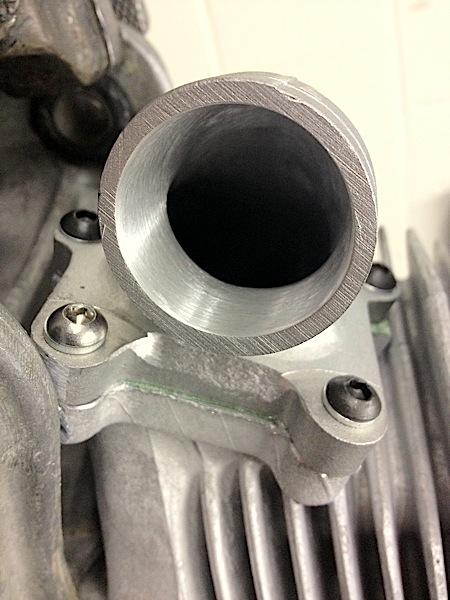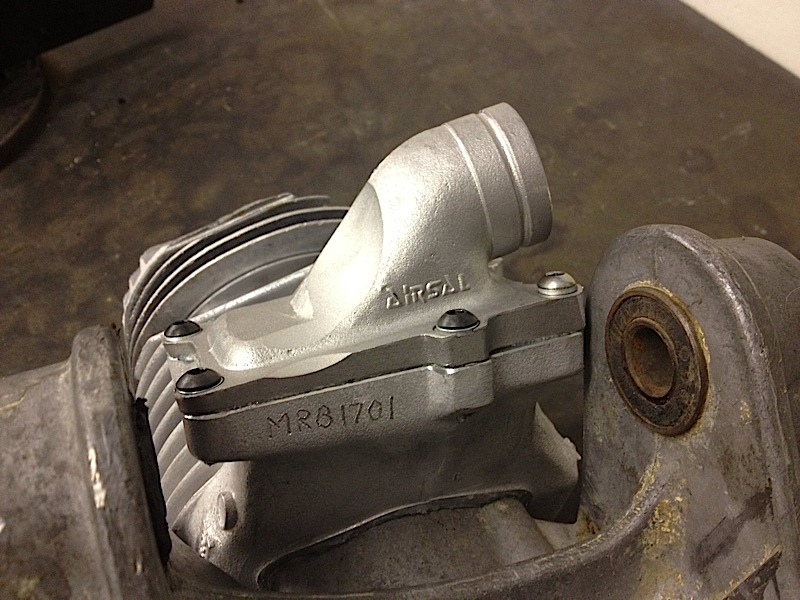SMALL BLOCK RB20, 200
The RB20 (200) is AF Rayspeeds last of the RB range to be made, the difference is, this is the small block version to suit 125, 150 and 175 engine casings. As with the RB225 and 250 it’s a Reed Valve cylinder but only really aims at competing with the Imola 190 or the GT 190 reed valve cylinders and lately the Quadrini 200 – which is very similar to the RB200. Given the choice I would use the Quadrini – it still has its faults but is much better and both the RB and Quadrini you have to buy the same type of crank and a new exhaust so not much in it price wise. The RB20 has many similar features compared with the large block versions BUT now comes with either a pattern Yamaha piston or lately a Vertex piston at 66mm and now uses a 58mm crank with the longer 116mm TV style con rod! Because of this the RB20 is an oddball and needs a totally different crank or a con rod conversion doing over what has become standardised with the large block versions using a standard 107mm or slightly longer 110mm con rod.
But how much difference is the this RB compared to the 225 and 250 version?
The main difference is the RB20 will only fit the small block cylinder stud spacings so is not interchangeable. As with the 225 version the RB20 fits onto a small block casing and doesn’t need boring out like the 250 version. The RB20 is nearly the same as the large block versions to look at apart from the exhaust port has been made with the much more reliable standard traditional single exhaust port.
EXHAUST PORT
The RB range of cylinders use a different designed exhaust stub – which now points towards the rear of the bike, the port and studs are the same as the gasket of a TS1 but the exhaust is different and needs to be changed or you need to modify an older exhaust. Why the flange was altered I’m not exactly sure, maybe it was thought that gases come out of the exhaust port at a better angle like the Small Frame Vespa or maybe it was done to increase exhaust height from the floor. Either way I get more power from standard style TS1 flanges. I also tried this sloped flange on my own TS1 power valve cylinder and it made no difference over a standard style flange, it just caused a problem when dynoing as all the exhausts needed altering to suit. Today there are a number of good exhausts made to suit the RB cylinders.
The RB20 uses a single exhaust port compared to the early RB250 which used 3 exhaust ports but later castings went to one exhaust port.
TRANSFER PORTS
The RB uses two transfer ports each side of the bore giving 4 in total, like the TS1’s design but the RB transfers are wider and taller. The transfer feeds are a similar size to a TS1 and ideally needs the casings matching to suit.
BOOST PORTS
The RB20 uses three boost ports to increase area like the RB250, the 225 version uses 2. Two ports are angled correctly one is not and don’t understand why they did this, it pushes fuel straight out of the exhaust port and does nothing to encourage the 2 stroke cycle.
INLET PORT
The inlet port is now much larger compared to the TS1 it now houses a totally new 8 petal reed block with 6 mounting points. For the reeds to fit, the casting around the inlet is larger, this helps to feed the newer Boyesen port feeds (holes from the inlet port to the transfers) into the 2 transfer ports which is similar to many modern 2-stroke cylinders.
REED VALVE
The RB uses a design like the V-force Reed blocks but goes one step further with a very clever designed split reed block where each side uses 4 petals and as it’s pushed in place in the cylinder it clips together. The reeds are made of black carbon and up to date there are no modern standard replacement which will fit without modification.
INLET MANIFOLD
The RB uses a new totally new inlet manifold to suit the 8 petal reed block and is designed again like the TS1 which comes out on the right hand side and is designed to fit a 35mm TMX, 34mm Amal or a 34mm Dellorto with a stepped up rubber or a 30mm Dellorto with a stepped down rubber.
CYLINDER HEAD
Early RB20’s uses a modified Indian 150 head. Today they come with a Indian made center combustion chambered head with a side spark plug. These are machined with a 0.5mm step to aid squish clearance but I’m not sure why! As the kit comes with gaskets, so a flat head would have been better. Early heads were machined in a two step manor, towards the outside the head is machined to suit the flatish dome of the Yamaha piston then there is another curved step cut for the Lambretta piston. Maybe the one we saw was machined just to use up a 175 Lambretta head. Either way it’s not quite right, the squish band is very small and will not promote a very good power output. What this design has done is got the compression ratio to below 10:1 more like 9.5:1 which isn’t a bad thing as you need to keep these highly strung high revving engines reliable with our crap fuels! Later heads with center dome have the squish band machined wrong and is on a taper – tight at the outside tapered to the inside. The compression ratio now comes out at 10.5:1 which you could say is a tad too high- but work out the corrected compression ratio with the large exhaust port and its about spot on. With the later heads you can not machine them as the spark plug is so close to the piston on assembly.
CRANKSHAFT
The only way the RB20 can be used with the short crown height piston supplied is use a 58 x 116mm crank and con rod same set up as the original Tv175. Always thought to be the smooth engine set up for less vibration. In theory a con rod should be twice the stroke 58 x 2 = 116mm. Which works perfect with the very reliable Yamaha type pistons used with the 32mm crown height pistons.
PORTING LAYOUT
The style of porting layout and port timings make this kit an on off kit in terms of power, some say they are really powerful low down but I have haven’t seen a dyno graph to prove this compared to many other kits which are more suited to low down torque. The RB is a race kit, it’s not really designed as a touring kit but can be made into one. With the port spec the power kicks in at around 5 – 6000rpm and takes off when the porting and exhaust comes on song. This instant power is so harsh people love the RB for a fun thrash bike. But there are problems in the design as I see it. The porting spec is wrong and can be improved to either help power spread or increase power. It’s thought that the new Boyesen transfer port feeds from the inlet port into the transfer port stops oil fuel lubricating the big end bearing, I’m not convinced this is really the case. If the crank has a good rod, shims and bearing arrangement with good oil there should be enough oil mixture to lubricate the big end and bore. Exhausts need either replacing and buying new to fit the kit or an exhaust needs modifying, as the kit has large porting specs the exhausts power usually comes in high up in the rev range, this usually gives a good top end revving engine and it’s not uncommon to see 10’000rpm through the gears with a wide spread from 7000rpm.
WHAT TO LOOK OUT FOR
The RB20 cylinders seems to be very reliable, the single exhaust port works much better over the triple versions, everything else seems to work well, with no reported problems apart from long term ones. I’ve found the cylinder is tight on the cylinder studs (even relieved studs) and you have to drill the 4 long holes out to at least 9mm and was still tight (they all seem to be the same even on perfect Innocenti casings). Care is also needed to make sure the cylinder fits inside the casing as the spigot is very thin. Also check head gaskets and heads slide on the studs. Heads are not machined correctly to the bore so the piston could hit the head and or gasket. I dowel these heads to make sure they are correct – I’m thinking the main stud holes are machined slightly off causing these problems.
The Reed block has large reed petals and can tend to spit and crack, which normal Carbon reeds can do anyway, this is more relevant when dyno testing. I’ve known petals shatter in 20 dyno runs but it does happen on the road which can pop a pistons. Ideally a new reed block needs designing with smaller bridges to make it more reliable. When I tune these cylinders the cutters fly through the plating unlike other cylinders! They also chip away really easy making tuning a nightmare and you need lots of tooling and skill to tune one. With Nicasil plating like the TS1 or Ceramic plated, long term they would be a better kit. If the plating is soft the cylinder could wear out. Some castings come with holes in them. I’ve also seen a lot of the green gaskets supplied in the kit on the inlet and base break up and go mussy, which can then cause major problems, but it’s not just the RB which has this problem most kits do because of fuels these days and the quality of gasket materials.
Always use a fuel resistant sealer on the faces like what MB sells.
Why the piston was swapped to a Yamaha style is beyond me, all I can think it was to save money or as said to try and make a smoother engine with the longer con rod. Yes this works and the piston is good and available from many sources but it instantly alienates the kit with no standardisation and needs an oddball crank or con rod swap! Early pistons had the two ring pegs run directly into the boost ports….. which history says pegs will wear loose at some point. The Pattern ART piston had a poor circlip which was too long and needed taping in place to fit, if I didn’t see that the circlip would have come out! Later Vertex piston have the pegs positioned perfectly. The RB cylinders are bored to it’s limit, when this happens the spigot is very thin, to get around this the cylinder is cast, part machined and after plating the spigot area is machined again, this should keep the bore true, I find the 200 version is so thin the piston can be tight at BDC and required half the spigot trimming off and honing out. When I’ve machined the base to suit the 115mm con rod the base area was machined all over the place when I set it up on a mandril running true! So always use silicone sealer at the base to make sure it seals.
WHAT CAN BE DONE TO IMPROVE THE KIT
Of course I can tune these kits, but it’s not just a case of increasing all ready over sized ports. As with what we suggest with the TS1 cylinder the same ideas can be used. The transfer ports are to tall, this does give ‘my RB pulls from nothing’ but what it does is over fuel low down in the revs and spit fuel out of the exhaust port which is no good for fuel economy. This design also shows on a dyno with a big dip at 4000 – 5000rpm. So as with the TS1 touring tune you can either machine 0.5 – 1.5 – 2mm off the base of the cylinder to lower the transfer timings. When you do this you need a fat head gasket or machine a recess into the head to get the squish clearance correct BUT BE CAREFUL don’t let the top ring come out at TDC. Later cylinders have slightly lower port timings. You could weld a new fin on the top and machine the base, but really its an expensive way of curing a major problem – you would be better using a different cylinder.
With this kit you need a 116mm TV style con rod, I say style as there some thicker improved con conversions, I would still prefer to use a Yamaha 115mm RD con rod conversion in a GP type crank. An extra 1mm needs removing from the base if a Yamaha 115mm rod is used. If this is done then the cylinder may hit the engine mount casting so will need cleaning up before fitting. You could fit a 60mm crank, this would reduce port timings which will need to be looked at, then head/head gasket needs looking at. Modern cranks with modern 116mm con rods are perfectly suited to this kit saving the extra work fitting the Yamaha 115mm con rod. We would recommend the SIP 58x116mm cranks these are excellent.
Once I set up the porting like this to reduce the transfer timings below 130 degrees it will lower where the power comes in. You can increase the exhaust port timing and increase the width to get the power back up to where it was with a wider power band. All that needs doing to the other ports is a bit of cleaning. I have fully welded transfers and cut inlet feeds into the crankcase and gained no power.
On the inlet manifold side, all that needs doing is some flowing, I have dynoed back to back the standard inlet manifold against a flowed one and one filled up and reshaped…….. standard worked just as good. The inlet system although looks rough and chunky works fine but I do like to do a nice job so sometimes I cut out the bridge in the inlet and let the reed bridge do it’s job.
Piston wise the standard one should be ok, there are stronger ones available or you could improve it by fitting the IT175 piston which I’ve used in TS1 200 from day one in the 80’s, the IT piston has wider ring pegs and one is supported better. Theres nothing wrong with the later Vertex piston so use that. Or on a damaged cylinder the boost ports could be welded up, re positioned and re shaped to suit the piston and this can improve power and reliability. The only difference in pistons is the IT has a lower compression height by 0.5mm so squish clearances need checking.
Tuning the RB and repairing a RB is quite involved and takes more time than similar cylinders so expect more costs. If you need work doing then please get in touch, ideally as with all cylinder kits we need to the cylinder, head, piston and inlet manifold.

Shows where a standard Italian casing is and how much can be machined out

If using later Spanish or SIL casings you could make the transfers bigger, the casting on the cylinder can take it

Machined base area and transfer matched and flowed, just needed the spigot altering in size
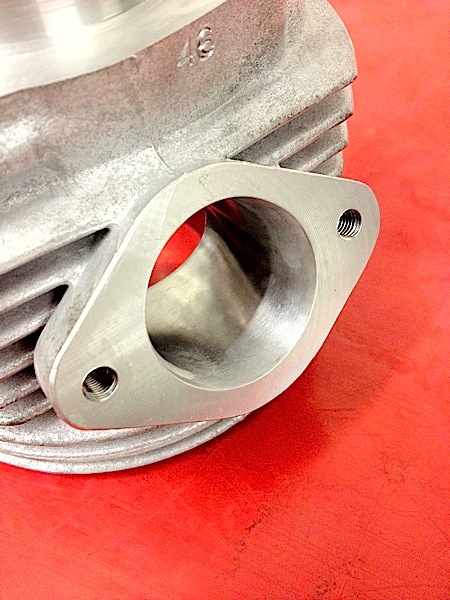
Exhaust port opened and flowed

The standard RB20 boost port arrangement
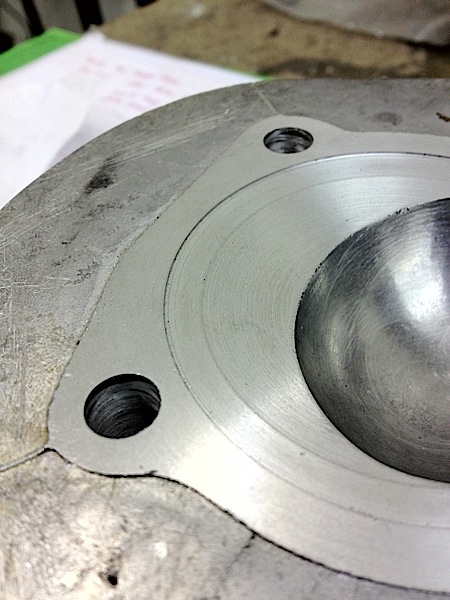
Strange standard head, recessed, and double cut
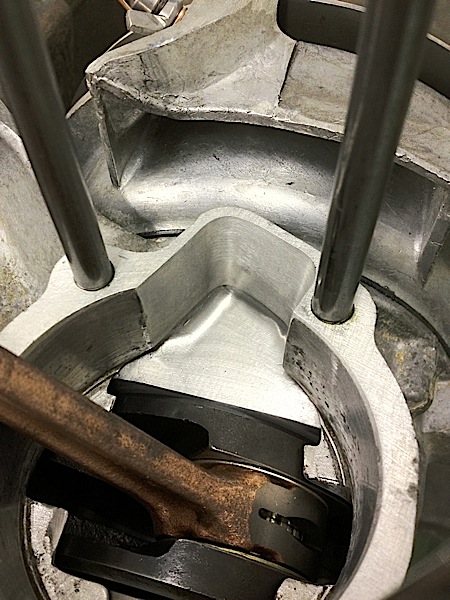
Transfers opened to the max in a bit of a dog of an old casing with a MB Yamaha 115 con rod conversion
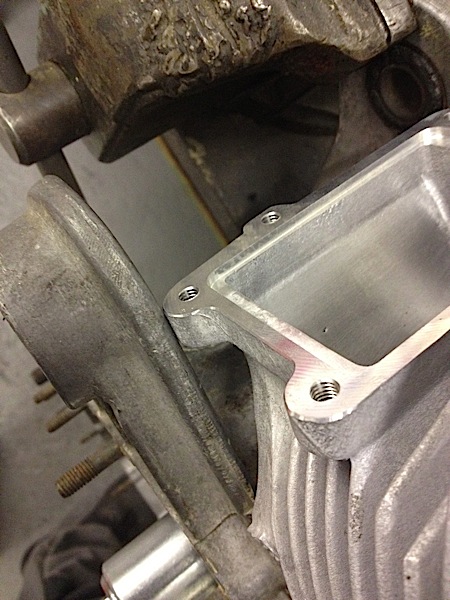
When the cylinder base is machined the cylinder touches the casing so needs cleaning up
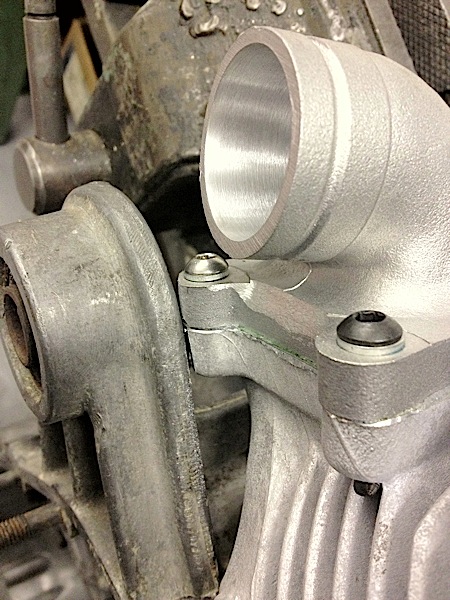
Cleaned up to clear and fitted with a flowed inlet manifold
Tuned and flowed inlet manifold
All fitted and done MRB1701
Mark Broadhurst, any questions email mark@mbscooters.co.uk






